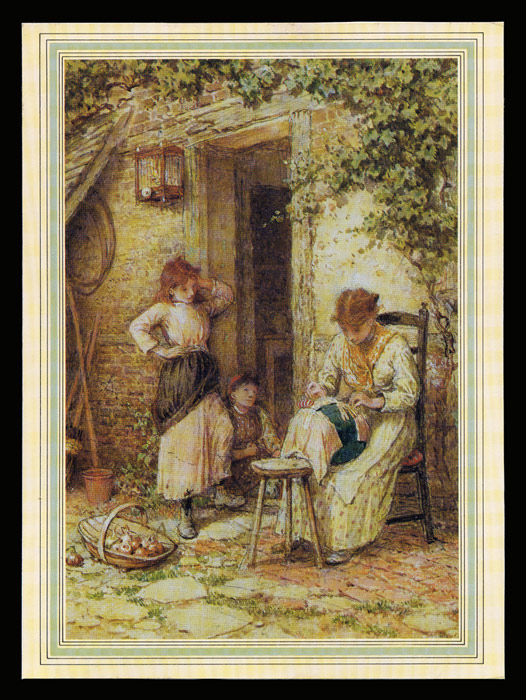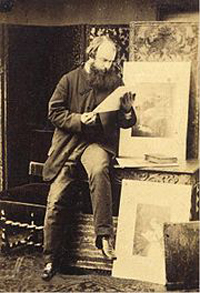English PrintsPrevious | English Prints Index | NextHome |
Myles Birket Foster "A Lacemaker" 8" high by 6" wide. Partial print of the entire work. The original "A Lacemaker" is a signed watercolor over pencil heightened with bodycolour, measuring 8.1" x 10.8". On March 20, 2007, it sold at Bonhams in London, New Bond Street, for 10,500 GBP ($19,312). It is not dated. 
See http://www.humrichfineart.com/foster.html, and http://www.victorianweb.org/painting/foster/index.html Miles Birket Foster (4 February 1825 – 27 March 1899) was a highly successful English illustrator and watercolor artist. He was born in North Shields, and his family moved to London where he was apprenticed at 16 to a wood-engraver, Ebenezer Landells (1808-60). Landells recognized Foster's talent for drawing and set him to work designing blocks for engraving. After his apprenticeship, he worked as a draughtsman under Henry Vizetelly, where he began to illustrate books. Foster also provided designs for Punch and the Illustrated London News. In 1846 he set up as an independent illustrator, because he was already becoming famous as a draughtsman of rural scenes. The rustic vignettes of the seasons that he contributed to the Illustrated London News and its counterpart, the Illustrated London Almanack, established him as a charming interpreter of the English countryside and rural life and led to his employment illustrating similar themes in other publications. During the 1850s his designs were much in demand; he was called upon to illustrate volumes of the poetry of Longfellow, Sir Walter Scott and John Milton. His most celebrated illustrated book, Pictures of English Landscapes (1863), with verses by Tom Taylor, he conceived as a showcase. It contains thirty full page wood engravings, cut by the Dalziel Brothers. He began to exhibit in 1859 and was elected Associate of the Old Watercolour Society in 1860 and full Member in 1862. In the course of his exhibiting career, he showed some four hundred works at the Old Watercolour Society's galleries and his watercolours were also extensively exhibited by London dealers, particularly Agnew's and Dowdeswell's. In fact his work was so popular with the public that dealers virtually fought to purchase it and used to race each other from Witley Station to his home when he had work to sell. While rural England was the inspiration for much of his work, Foster travelled regularly on the Continent, gleaning material for publications and watercolours. In 1852 he journeyed down the Rhine, seeking subjects to illustrate an edition of Longfellow's Hyperion. Another tour through Belgium, Germany and Switzerland in 1854 provided material for The Rhine and its Picturesque Scenery (pubd 1856). In the 1870s he made a number of trips to Italy while engaged on a commission from a Lincoln corn merchant, Charles Seely, for 50 watercolours of Venice. Visits to Brittany resulted in a volume of 35 lithographs published by the artist in 1878. In 1893 illness forced Foster to sell his home, together with most of his collection of pictures. He moved to a smaller house in Weybridge, Surrey, where he continued to paint until his death. first posted 8/4/2009 |
 |
References Cundall, H.M. Birket Foster RWS. London: A. & C. Black Ltd., 1906. Hardie, Martin. Water-colur Painting in Britain III. The Victorian Period. Ed. Dudley Snelgrove with Julian Mayne and Basil Taylor. London: Batsford, 1968. Lewis, Frank. Birket Foster. Leigh on Sea: Lewis, 1973. Reynolds, Jan. Myles Birket Foster. London: Batsford, 1984. Spielmann, Sir Isidore. Souvenir ofthe Fine Arts Section, Franco-British Exhibition 1908. London: Bernrose and Son, 1908. |
